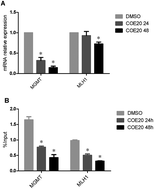Specific histone modifications were associated with the PAH-induced DNA damage response in coke oven workers†
Abstract
To investigate whether polycyclic aromatic hydrocarbon (PAH) exposure is associated with specific histone modifications and whether DNA damage triggers epigenetic alterations, we recruited 190 male workers with occupational exposure to PAHs and 100 male control workers from Benxi Steel Plant, Liaoning province, China. Urinary 1-hydroxypyrene (1-OHP), DNA damage, specific histone modification levels and the expression of selected DNA damage response (DDR) genes were measured in peripheral blood lymphocytes (PBLCs) of the subjects. The results showed that trimethylated Lys 27 of histone H3 (H3K27me3) and trimethylated Lys 36 of histone H3 (H3K36me3) were elevated in the PAH-exposed group (both P < 0.001), while trimethylated Lys H3 of histone H3 (H3K4me3) was decreased compared to the unexposed group (P < 0.001). Notably, H3K36me3 was positively associated with the level of internal exposure marker 1-OHP (β = 0.197; P < 0.001) and the degree of DNA damage (β = 0.175; P < 0.001) in all subjects, indicating that the PAH-induced DNA damage response might be mediated by H3K36me3 and/or H3K4me3 modifications. Particularly, the ChIP-qPCR assay revealed that the modifications of H3K36me3 were enriched in the gene body of DDR genes, MGMT and MLH1. The up-regulation of MGMT and MLH1 was correlated with the elevated H3K36me3 in the PAH-exposed workers (P < 0.001). Collectively, we revealed that H3K36me3 could be an indicator of PAH exposure and might be involved in the transcriptional regulation of DNA repair genes in response to DNA damage.


 Please wait while we load your content...
Please wait while we load your content...